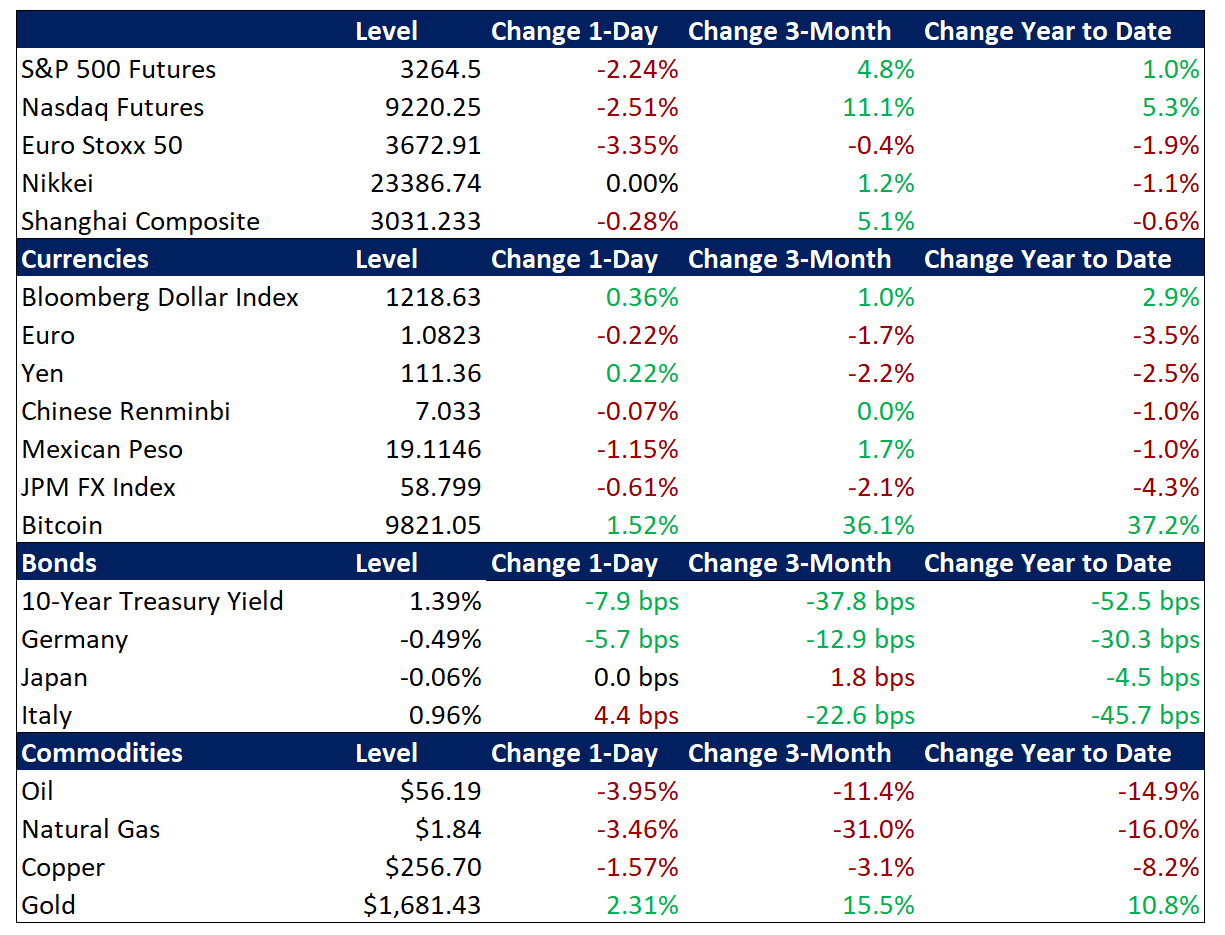Summary and Price Action Rundown
Global risk assets were sharply lower overnight as the rapid spread of coronavirus cases outside China doused hopes of swift containment and spurred meaningful market volatility. S&P 500 futures indicate a 2.2% plunge at the open, which would extend the losses from the past two sessions but still keep the index within 5% of last Wednesday’s latest record high. Apparently slowing infection rates in China had fueled optimism over the past few weeks that the impact of the epidemic would be shallow and fleeting. However, news of widening outbreaks in other countries, questions about China’s diagnostic data, warnings from corporates over the growing impact, and early signs of the economic toll have led to re-intensification of risk aversion in global stock markets. Overnight, equities in Asia were mostly lower, though mainland Chinese markets again outperformed, while EU stocks have plummeted over 3%. Treasuries are rallying amid a rush for safe havens, with the 10-year yield near a record low at 1.39%. The dollar is also gaining, with a closely-followed dollar index near multi-year highs. Crude oil prices are retreating, with Brent trading near $56 per barrel.

Coronavirus Spread Outside China Roils Markets
Swelling outbreak figures in Italy, Iran, South Korea and other countries are forcing investors to confront the likelihood of a wider, lengthier, and deeper impact of the epidemic. Italian equities are nearly 5% lower this morning and its sovereign bonds are underperforming as the rising number of reported coronavirus cases in northern Italy hit local assets, while also impacting investor sentiment more broadly. Similar outbreaks in Iran and South Korea, as well as reports of the spread to other countries, are dispelling optimism over the prospects for containment, which had lifted global equity markets over the past few weeks. This latest phase of the epidemic began last week as market participants started warily monitoring reports of an expanding outbreak in South Korea, as well as new fatalities in Japan. Meanwhile, analysts continue to question the credibility of the outbreak data in China as officials in Hubei province, the epicenter of the outbreak, have shifted the diagnosis guidelines twice over the past two weeks and issued conflicting statements on the quarantine of the city of Wuhan. Now, total infections are reported to be 79,524 while fatalities have reached 2,626. Meanwhile, the list of corporates reporting a significant impact on their business continues to grow, with Goldman Sachs suggesting that the likely impact on earnings has been broadly underestimated.
Global Economic Data Suggests Unfolding Outbreak Impact
Preliminary readings of February’s manufacturing and service sector purchasing managers’ indexes (PMIs) showed a regional divergence suggestive of intensifying virus-related headwinds in Asia alongside unexpected weakness in the US. For context, PMI readings above 50 denote expansion in the sector. The IHS Markit Manufacturing PMI for the US fell to 50.8 in February from 51.5 in January, missing forecasts of 51.5. This is the lowest level since August as output growth slowed and firms noted that weak demand conditions and delays in deliveries following the outbreak of the coronavirus in China had dented production. More troubling for the US economy, however, was the drop in the Services PMI to 49.4 from 53.4 the previous month, which dramatically undershot estimates of 53.0. This was the first contraction in the US service sector PMI since February 2016. Overseas, Australian PMIs showed contraction across the board, with the composite reading at 48.3. Japan posted similarly downbeat figures, as the composite PMI registering a steep retrenchment at 47.0 versus 50.1 the prior month. Meanwhile, the UK’s February PMIs surprised to the upside as a better-than-expected 53.3 composite PMI matched January’s pace. EU PMIs were subdued, with the composite at 51.6, but all three gauges moderately outpaced consensus estimates and January’s readings. Still, the economic impact is expected to be more acute in Asia, the EU, and emerging markets than in the US, fueling a surge of demand for Treasuries and the dollar that has sent Treasury yields toward record lows and the dollar to a multi-year high.
Additional Themes
Treasury Markets Reflect Deepening Concerns – The 10-year Treasury yield is now trading at 1.39%, nearing the prior all-time intraday low of 1.32% registered during the global deflation scare of 2016. Treasury yield curves (the yield spread between Treasuries of differing maturities) are also flattening, and in some cases inverted, which is considered a harbinger of impending recession. The most closely-watched portion of the yield curve, the 2-year/10-year segment, is only 11 basis points above inversion. Meanwhile, futures markets are pricing in more than two Fed rate cuts over the coming year.
President Trump in India – Analysts are noting the announcement of $3 billion in military sales to India as well as the President’s references to a broader trade deal, although the virus-related global selloff is muffling any observable price response in US defense stocks or Indian assets.
